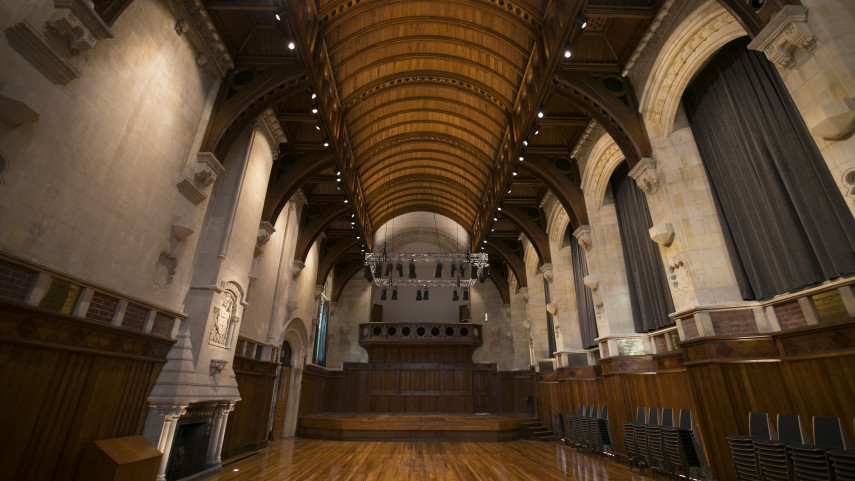Council has a regulatory role in the protection of heritage places under the Resource Management Act 1991.

These heritage schedules within the Christchurch District Plan(external link) provide regulatory protection for heritage places:
- Schedules of sites of Ngāi Tahu cultural significance(external link)
- Schedules of significant trees(external link)
- Schedule of significant historic heritage(external link)
- Schedule of heritage areas(external link)
The schedules of heritage items (sites) and heritage areas are supported by the Council’s Heritage Team in consultation with Council resource consent staff.
Council heritage staff and consultants provide specialist advice to owners and Council resource consent staff at the pre-application and application stages.
Heritage staff also work with Building Consent Officers to find practical solutions where Building Act requirements have the potential to impact heritage values.
Resources are primarily targeted at heritage items scheduled in the Christchurch District Plan(external link). This support includes:
- Conservation advice for all types of heritage buildings. Best practice conservation principles contained in the ICOMOS New Zealand Charter 2010 are promoted as far as practical in the Canterbury post-earthquake context.
- Advice on resource consents for works to scheduled heritage items, including discussions and site visits before any applications are made.
- Access to hard copy heritage files for scheduled heritage items and some non-scheduled items which are able to be viewed at the Civic Offices by appointment.
Contact the Council’s Heritage Team at heritage@ccc.govt.nz.
Proposed changes to the heritage rules and heritage schedules in the district plan were publicly notified on 17 March 2023 under Plan Change 13 - Proposed Heritage Plan Change(external link) and duplicated in the relevant chapters in Plan Change 14 - Proposed Housing and Business Choice Plan Change(external link).
These changes include adding new places to the schedule of protected heritage items and new protection for residential heritage areas. The new provisions have immediate legal effect alongside the operative district plan provisions until the final plan change decisions are made.
The schedule of significant historic heritage is contained in Appendix 9.3.7.2 of the District Plan(external link). Items (sites) are identified as Highly Significant (Group 1) or Significant (Group 2).
For each scheduled item, the schedule includes a link to a Statement of Significance, which summarises the history and heritage values of the site, and a link to a heritage aerial map, which shows the extent of the protected heritage item and its associated heritage setting.
Heritage areas are scheduled in Appendix 9.3.7.3(external link).
Planning Maps, which identify the location of heritage items and their settings and heritage areas, can be accessed via links in the schedule (for heritage items) or by searching the district plan online property search(external link).
Contact the Council’s Heritage Team at heritage@ccc.govt.nz.
Proposed changes to the heritage rules and heritage schedules in the district plan were publicly notified on 17 March 2023 under Plan Change 13(external link) (Proposed Heritage Plan Change) and duplicated in the relevant chapters in Plan Change 14(external link) (Proposed Housing and Business Choice Plan Change). These changes include adding new places to the schedule of protected heritage items and new protection for residential heritage areas. The new provisions have immediate legal effect alongside the operative district plan provisions until the final plan change decisions are made.
Resource consent is required for some works to heritage items scheduled in the Christchurch District Plan, while other works are permitted subject to meeting certain standards.
The Christchurch District Plan(external link) provides for the protection of significant historic heritage while also recognising the impact of the Canterbury Earthquakes and engineering and financial factors on the ability to retain, restore and continue using heritage items.
The rules for heritage items and heritage settings are generally contained in Chapter 9.3 of the District Plan(external link).
Maintenance, repairs, and heritage investigative and temporary works (external link)are generally permitted subject to meeting standards in the District Plan(external link).
Signs are permitted on heritage items or in heritage settings where they comply with the rules for signage in the zone(external link) and meet the permitted standards in the historic heritage rules in the District Plan.
In some cases, work must be carried out under the supervision of a heritage professional. Heritage upgrade works, reconstruction and restoration can be carried out as a permitted activity if a Heritage Works Plan certificate (P-025) [PDF, 70 KB] is obtained.
This applies to Highly Significant (Group 1) items where the works are required as a result of damage, and to Significant (Group 2) items. The Heritage Works Plan must be prepared by a heritage professional and certified by the Council.
Resource consent is required for:
- demolition or partial demolition of a heritage item
- alteration of a heritage item
- relocation of a heritage item within or beyond its setting
- new buildings in a heritage setting or in a heritage item which is an open space
- subdivision of a heritage setting or a heritage item which is an open space (see Chapter 8 - 8.5.1.3 RD10 in the District Plan(external link))
- earthworks in a heritage setting or in a heritage item which is an open space where they are above the permitted volume for the zone or within five metres of a heritage item (see Chapter 8 - 8.9.2.1 P1 (i) in the District Plan(external link)).
- any works that don't meet the permitted activity standards in the District Plan(external link).
The rules vary depending on the type of work proposed and the significance of the heritage item. For more information about the District Plan rules for your particular site please contact our Duty Planner via email to dutyplanner@ccc.govt.nz.
Advice and assistance to owners of heritage items are also available from the Council's Heritage Team at heritage@ccc.govt.nz.
The heritage rules in the District Plan(external link) restrict what may be done with heritage fabric.
A certificate can be requested from the Council to confirm that particular fabric is not heritage fabric, and is therefore not subject to the operative heritage rules in sub-chapter 9.3. Please discuss with the Council's Heritage team before preparing an application as there are relevant changes to the rules in Plan Change 13(external link).
The Non-Heritage Fabric (P-026) [PDF, 69 KB] request form must be accompanied by an assessment from a heritage professional(external link).
A heritage professional(external link) is a person with specific qualifications and experience in heritage conservation or management, as defined in Chapter 2 of the District Plan as amended by Plan Change 13. This heritage definition in Plan Change 13(external link) had immediate legal effect from the time of notification and is treated as operative as the submissions period has closed and there were no submissions on this definition.
Some of the heritage rules allow work to be carried out without resource consent if a heritage professional is involved.
The people below have demonstrated the experience necessary to meet the definition of a heritage professional.
When contacting a heritage professional, you will need to check whether they consider the proposed works to be within their professional remit or not.
- Maria Adamski, maria.adamski@ccc.govt.nz, 027 232 7594
- Ian Bowman, ian@ianbowman.co.nz, 027 445 7813
- Alec Bruce, alecb@wilkieandbruce.co.nz, 03 379 7739
- William Fulton, william.fulton@teamarchitects.co.nz, 03 366 7165 or 027 269 2759
- Patrick Harsveldt, patrick@heritagearchaeologyservices.co.nz, 027 498 3078
- Phillip Hartley, philliph@salmondreed.co.nz, 09 445 4045 or 021 372 277
- Tracey Hartley, traceyh@salmondreed.co.nz, 09 445 4045 or 021 372 388
- Wendy Hoddinott, wendy@gatherla.nz, 0274 766 813
- Tim Holmes, tim.holmes@heritageworks.co.nz, 021 024 20829
- Carole-Lynne Kerrigan, clkheritage@gmail.com, 021 671 355
- Jenny May, jenny@hms.net.nz, 03 323 5732 or 027 593 7310
- Dave Pearson, dave@dpaarchitects.co.nz, 09 445 8544 or 027 497 2205
- Chessa Stevens, chessa@chessastevens.co.nz, 0274 994 796
- Alex Vakhrousheva, avakhrousheva@heritage.org.nz, 027 286 7680
For more information on this list, contact the Council’s Heritage Team at heritage@ccc.govt.nz.
These guidelines were developed soon after the first Canterbury earthquake in 2010.
They are intended as guidelines for owners of heritage and character buildings to assist with repair and maintenance of these buildings and apply to any earthquake or building damage.
- Heritage Guideline 1 [PDF, 259 KB] – Safe and secure
- Heritage Guideline 2 [PDF, 335 KB] – Repairs to the heritage building
- Heritage Guideline 3 [PDF, 305 KB] – Reconstruction of elements
- Heritage Guideline 4 [PDF, 215 KB] – Strengthening of buildings
- Heritage Guideline 5 [PDF, 148 KB] – Professional advice and tradespeople
- Heritage Guideline 6 [PDF, 203 KB] – Heritage Recovery - Guidelines for building owners
Projects involving demolition of buildings or earthworks on sites associated with pre-1900 human activity may also have separate obligations relating to archaeological sites under the Heritage New Zealand Pouhere Taonga Act 2014 (NZHPT Act)(external link) administered by Heritage New Zealand Pouhere Taonga (HNZPT).
Areas of the Christchurch District with a known high concentration of archaeological sites include: Sumner, Redcliffs, Birdlings Flat, the Central City, Lyttelton and Akaroa. If you are proposing demolition of a pre-1900 building or other earthworks which could modify or destroy a site occupied before 1900 you should check your obligations with HNZPT.
For more information about archaeological sites and the Archaeological Authority process, visit the HNZPT website(external link) or contact HNZPT’s Southern Regional Office at archaeologistcw@heritage.org.nz or 03 363 1880.
Heritage New Zealand Pouhere Taonga
Heritage New Zealand Pouhere Taonga (HNZPT) is an autonomous Crown entity with the role of identifying, preserving and promoting New Zealand’s heritage under the Heritage New Zealand Pouhere Taonga Act 2014 (HNZPT Act)(external link).
HNZPT offers heritage advice and maintains and administers Rārangi Kōrero/The New Zealand Heritage List(external link) which includes Historic places, Historic areas, Wāhi tūpuna, Wāhi tapu and Wāhi tapu areas.
HNZPT advocates for the entries on the list. Statutory protection of heritage sites and areas sits under the District Plan. Most significant heritage items in the district will appear on both the Christchurch District Plan schedule and the Heritage New Zealand list, however, there may be cases where places do not appear on both. The council consults with HNZPT in relation to entries on the Rārangi Kōrero/The New Zealand Heritage List.
Under the HNZPT Act, Heritage New Zealand is charged with the protection of archaeological sites. For information on archaeology and the requirements for Archaeological Authorities, visit Heritage New Zealand(external link).
If you require any information on Heritage New Zealand Pouhere Taonga listed places, heritage orders, or covenants, contact the Heritage NZ Southern Regional Office:
- Physical address: 64 Gloucester Street, Christchurch 8013
- Postal address: PO Box 4403, Christchurch Mail Centre 8140
- Phone: 03 363 1880
- Email: infosouthern@heritage.org.nz
ICOMOS Aotearoa New Zealand/Te Mana ō Nga Pouwhenua ō Te Ao
The International Council on Monuments and Sites (ICOMOS)(external link) is a non-governmental organisation of heritage professionals engaged in the conservation of places of cultural heritage value and dedicated to the conservation of the world's historic monuments and sites.
The ICOMOS New Zealand Charter for the Conservation of Places of Cultural Heritage Value (ICOMOS New Zealand Charter 2010(external link)) is a set of guidelines on cultural heritage conservation.
The Charter is widely used in the New Zealand heritage sector and is a recognised benchmark for conservation standards and practice. It is used by central government ministries and departments, by local bodies in district plans and heritage management, and by practitioners as guiding principles.
The ICOMOS New Zealand Charter 2010 sits as part of the Council’s Heritage Strategy: Our Heritage, Our Taonga, which was adopted by the Christchurch City Council in 2019.
Applications for resource consent for scheduled heritage items should take into account the conservation principles of the ICOMOS New Zealand Charter 2010.
Related news

Akaroa Wharf focus of photography competition
Akaroa’s iconic wharf is set to be photographed hundreds of times over its final summer.
24 Nov 2025
Snapshots from Canterbury's past
Calling all photo buffs! It’s time for the annual Christchurch City Libraries Photo Hunt.
1 Oct 2025
Connecting with our region’s heritage
Find out more about the heritage of our district during the Christchurch Heritage Festival 2025.
24 Sep 2025